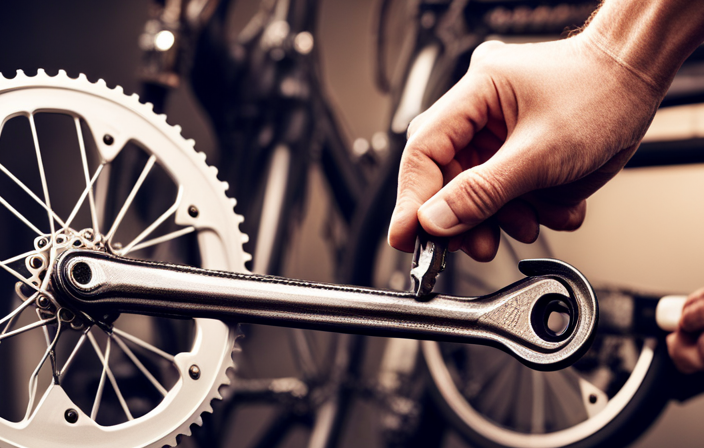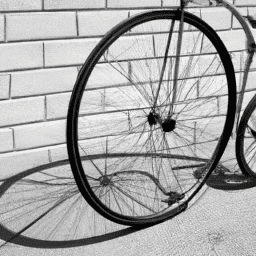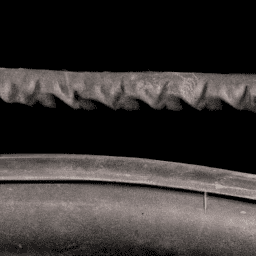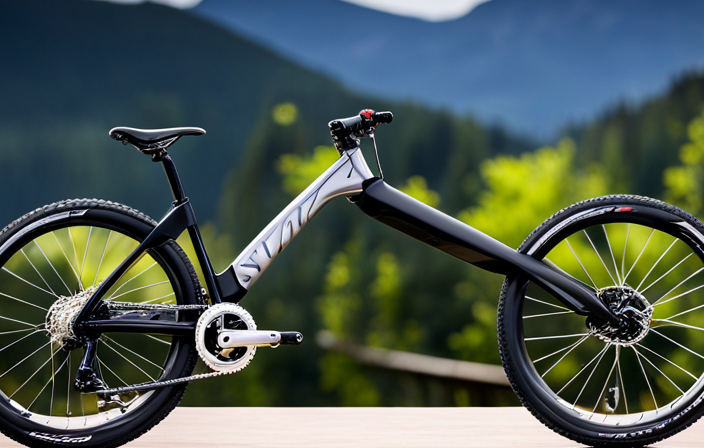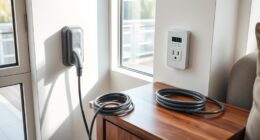As a dedicated cyclist, I have discovered that mastering the skill of replacing bicycle pedals is essential. I have found that having the correct pedals can significantly improve your cycling experience.
In this article, I will guide you through the step-by-step process of replacing your bicycle pedals. By following these instructions and using the necessary tools, you will be able to upgrade your pedals and enjoy a smoother and more efficient ride.
So, let’s get started and take your cycling to the next level!
Key Takeaways
- Greasing pedals is important for improving performance, preventing rust and corrosion, extending lifespan, ensuring smooth operation, and reducing potential issues.
- The steps to install new pedals include threading the right pedal into the right crank arm clockwise, threading the left pedal into the left crank arm counterclockwise, securely tightening both pedals with a pedal wrench, and avoiding over-tightening to prevent damage.
- Testing pedals for proper installation involves applying pressure and rotating the pedals to check for wobbling or looseness, listening for unusual noises or vibrations while pedaling, and ensuring smooth and quiet operation.
- Adjusting pedal tension can be done by locating the tension adjustment screw on the pedal body and turning it clockwise to increase tension or counterclockwise to decrease tension. Small adjustments should be made and tested after each adjustment, and the tension should be optimized for the rider’s style. Additionally, cleaning, lubricating, and checking pedals for wear and tear is important for maintaining their performance, and upgrading to clipless pedals may be necessary if signs of wear are present.
Gather the Necessary Tools and Equipment
Before you can replace bicycle pedals, you’ll need to gather the necessary tools and equipment. First, you should identify the type of pedals on your bicycle. There are two main types: platform pedals and clipless pedals. Platform pedals have a flat surface and are the most common type, while clipless pedals require special cycling shoes with cleats.
Once you have determined the type of pedals, you can prepare your bicycle for pedal replacement. Start by finding a comfortable and stable work surface to place your bicycle on. You’ll also need a pedal wrench or an Allen wrench, depending on the type of pedals. Additionally, it’s a good idea to have a rag or towel handy to clean any dirt or grime from the pedal threads.
With the necessary tools and equipment gathered, it’s time to move on to the next step: identifying the type of pedals on your bicycle.
Identify the Type of Pedals on Your Bicycle
First, determine the type of pedals on your bike. Identifying pedal types is crucial in choosing the right replacement.
There are two common types: platform pedals and clipless pedals. Platform pedals are the most basic and widely used. They feature a flat surface where you can rest your feet. Clipless pedals, on the other hand, require special cycling shoes with cleats that attach to the pedals.
Once you have identified the type of pedals on your bicycle, you can proceed to the next step of preparing your bicycle for pedal replacement. This involves removing any dirt or debris around the pedal area and ensuring that your bike is secure and stable. This preparation is essential to ensure a smooth and successful pedal replacement process.
Prepare Your Bicycle for Pedal Replacement
To prepare my bicycle for pedal replacement, I first secure it in a stable position by using a bike stand or propping it up against a sturdy wall. This ensures that the bike remains steady and prevents any accidents or damage.
Next, I make sure to remove any obstructions or accessories that may hinder the pedal replacement process, such as water bottle holders, bike bags, or fenders. This allows me to have clear access to the pedals and ensures a smooth and efficient replacement process.
Secure Your Bicycle in a Stable Position
Make sure your bicycle is in a stable position before attempting to replace the pedals. To stabilize your bicycle, follow these techniques to prevent pedal slippage:
- Find a flat surface or use a work stand to keep your bicycle steady.
- Place both wheels on the ground or secure the front wheel in a wheel chock.
- Use a bike rack or wall mount to hold your bicycle securely.
- Consider using a bicycle repair stand for optimal stability.
By ensuring your bicycle is in a stable position, you can work more efficiently and reduce the risk of accidents.
Once your bicycle is secure, you can proceed to the next step and remove any obstructions or accessories that might hinder the pedal replacement process.
Remove any Obstructions or Accessories
Once you have stabilized your bike, you’ll want to remove any obstructions or accessories that may interfere with the pedal replacement process. This will ensure a smooth and hassle-free experience. To help you visualize this process, here is a table outlining common accessories and potential obstructions you might encounter:
| Accessories | Potential Obstructions |
|---|---|
| Water bottle | Handlebar bag |
| Bike computer | Frame pump |
| Lights | Saddle bag |
| Bell | Rear rack |
By removing these accessories, you’ll have a clear workspace to work with. This will prevent any accidental damage to your bike or the accessories themselves. Now that your workspace is ready, we can move on to the next step of removing the old pedals, ensuring a seamless transition in the pedal replacement process.
Remove the Old Pedals
To remove the old pedals, the first step is to determine the correct pedal rotation direction. This is important because the left pedal has a reverse thread, meaning it loosens by turning it clockwise.
Once the correct direction is established, a pedal wrench or an Allen key can be used to loosen the pedals. The wrench or key should be inserted into the pedal spindle and turned counterclockwise to loosen the pedals.
Determine the Correct Pedal Rotation Direction
First, you should figure out the correct pedal rotation direction. This is important because bike pedals have different threading on each side. To determine the pedal direction, follow these steps:
-
Look for markings on the pedals: Many pedals have letters ‘L’ or ‘R’ indicating the left or right side respectively.
-
Check the pedal axles: The axle on the left side of the bike will have reverse threading, while the right side will have regular threading.
-
Use the ‘righty-tighty, lefty-loosey’ rule: If the pedal removal requires turning it clockwise, it has regular threading. If it requires turning counterclockwise, it has reverse threading.
-
Consult the bike’s manual: It may provide specific instructions for determining the pedal rotation direction.
Once you’ve determined the correct pedal rotation direction, you can proceed to the next step of using a pedal wrench or allen key to loosen the pedals.
Use a Pedal Wrench or Allen Key to Loosen the Pedals
Now that we know the correct pedal rotation direction, it’s time to move on to the next step in replacing bicycle pedals.
To loosen the pedals, we will need either a pedal wrench or an Allen key, depending on the type of pedals installed on the bike. These tools are essential for pedal maintenance and replacement.
To start, locate the appropriate wrench or key size that fits the pedal spindle. Insert the tool into the pedal axle and turn it counterclockwise to loosen the pedals. It may require some force, so make sure to hold the bike steady while applying pressure. Once the pedals are loosened, you can remove them from the crank arms.
With the pedals removed, we can now move on to the next section – cleaning and inspecting the pedal threads. This step is crucial to ensure proper installation of the new pedals.
Clean and Inspect the Pedal Threads
Start by cleaning and inspecting the pedal threads. This step is crucial to ensure the smooth functioning of the new pedals and prevent any thread damage. To inspect thread cleanliness, use a clean rag or brush to remove any dirt, debris, or rust that might have accumulated on the threads. Check for any signs of damage, such as stripped threads or cracks, as this could affect the pedal’s stability.
In addition, inspect the pedal spindles for any signs of wear or damage. Look for any bent or broken sections and ensure that the threads are intact.
By cleaning and inspecting the pedal threads thoroughly, you can identify any potential issues and address them before installing the new pedals. This will help ensure a secure and reliable connection between the pedals and the crank arms.
Next, we will move on to applying grease to the pedal threads to further enhance their performance and longevity.
Apply Grease to the Pedal Threads
To enhance the performance and longevity of your pedals, it’s time to apply grease to the threads. Greasing the pedal threads is crucial as it helps prevent rust and corrosion, ensuring smooth rotation and easy removal in the future. By applying grease, you create a protective barrier that keeps moisture and dirt away from the threads, reducing the risk of damage.
To further emphasize the importance of this step, let’s take a look at the following emotional comparison table:
| Without Grease | With Grease |
|---|---|
| Difficulty in removing pedals | Effortless pedal removal |
| Increased risk of thread damage | Reduced risk of thread damage |
| Potential rust and corrosion | Protection against rust and corrosion |
| Shorter pedal lifespan | Extended pedal lifespan |
By applying grease, you not only improve the overall performance of your pedals but also prevent potential issues down the line. Now, let’s move on to the next section and learn how to install the new pedals.
Install the New Pedals
Once you have applied grease to the pedal threads, it’s time for you to install the new pedals. The installation process is straightforward but requires attention to detail. Here are three important steps to follow:
-
Start by threading the right pedal into the right crank arm. Remember that the right pedal has right-hand threads, which means you need to turn it clockwise to tighten it.
-
Next, thread the left pedal into the left crank arm. Unlike the right pedal, the left pedal has left-hand threads, so you need to turn it counterclockwise to tighten it.
-
Use a pedal wrench to securely tighten both pedals. Make sure they are snug but avoid over-tightening, as it can damage the crank arms.
If you encounter any issues during the installation process, such as resistance or cross-threading, stop and seek professional assistance.
Now, let’s move on to the subsequent section about testing the pedals for proper installation.
Test the Pedals for Proper Installation
Now, it’s time to make sure your new pedals are properly installed by testing them.
Testing techniques can help ensure that the pedals are securely attached and functioning correctly.
Start by gently applying pressure to each pedal and rotating them forward to check for any wobbling or looseness. If you notice any movement, use a pedal wrench to tighten the pedals further.
Next, hop on the bike and pedal slowly while paying attention to any unusual noises or vibrations. A smooth and quiet operation indicates a successful installation. However, if you experience any issues such as grinding sounds or pedal slippage, it may be necessary to troubleshoot the problem.
In the subsequent section about adjusting the pedal tension if necessary, we will address these potential issues.
Adjust the Pedal Tension if Necessary
If needed, you can adjust the tension of the pedals to ensure optimal performance. Adjusting pedal tension can help troubleshoot any issues you may be experiencing with your pedals.
To adjust the tension, locate the tension adjustment screw on the pedal body. Using a 5mm Allen wrench, turn the screw clockwise to increase tension or counterclockwise to decrease tension. It is important to make small adjustments and test the pedals after each adjustment to find the optimal tension for your riding style.
If you still encounter issues with the pedals even after adjusting the tension, it may be necessary to clean and lubricate them. This will be discussed in the subsequent section to ensure smooth pedal operation.
Clean and Lubricate the Pedals
To ensure optimal performance, you should clean and lubricate your pedals regularly. Proper maintenance of your pedals is crucial for a smooth and efficient ride.
Cleaning your pedals not only removes dirt and grime but also prevents rust and corrosion. Start by removing the pedals from the bicycle using a pedal wrench. Use a brush and a mild detergent to scrub away any dirt or debris from the pedal surface. Pay close attention to the crevices and grooves to ensure a thorough cleaning.
Rinse the pedals with water and dry them completely before applying lubricant. Apply a few drops of lubricant to the pedal bearings and spindle, ensuring smooth rotation. Finally, wipe off any excess lubricant and reattach the pedals to the bicycle.
By following these cleaning techniques, you can prolong the lifespan of your pedals and enjoy a smoother ride. Remember to check the pedals regularly for wear and tear to maintain their performance.
Check the Pedals Regularly for Wear and Tear
Check your pedals regularly for signs of wear and tear to ensure they continue to perform at their best.
Regular maintenance is essential to prolong the lifespan of your pedals and prevent any potential accidents or malfunctions while riding.
When examining your pedals, pay attention to the condition of the pedal body, spindle, and bearings. Look for any cracks, dents, or excessive looseness in these areas.
Additionally, check for any signs of corrosion or rust, as this can affect the smooth rotation of the pedals.
If you notice any of these signs of pedal wear, it may be time to consider upgrading to clipless pedals, which offer improved performance and efficiency.
By keeping a close eye on your pedals and addressing any issues promptly, you can ensure a safe and enjoyable cycling experience.
Consider Upgrading to Clipless Pedals
As an avid cyclist, I have always been keen on maintaining my bicycle to ensure optimal performance. Checking my pedals regularly for wear and tear is an essential part of my routine. However, I recently considered upgrading to clipless pedals, which offer several benefits that enhance my riding experience. Clipless pedals provide a secure connection between my shoes and the pedals, allowing for efficient power transfer and a more stable ride. Moreover, they provide better control and allow for quick and easy engagement and disengagement. When choosing shoes for clipless pedals, I make sure to select ones with compatible cleats. These pedals and shoes combination not only improve my efficiency and performance but also reduce the risk of foot slippage. Transitioning into the subsequent section, it’s important to seek professional help if needed to ensure proper installation and adjustment of clipless pedals.
Seek Professional Help if Needed
If you’re unsure about installing or adjusting clipless pedals, it’s best to consult a professional. Seeking professional advice can save you time and frustration, ensuring that your pedals are properly installed and adjusted for optimal performance.
When troubleshooting common pedal problems, a professional can diagnose issues such as pedal squeaking, loose pedals, or difficulty engaging and disengaging from the clipless system. They have the experience and knowledge to identify and resolve these problems efficiently.
Additionally, professionals can provide guidance on selecting the right clipless pedals for your riding style and preferences. Remember, properly installed and adjusted clipless pedals can enhance your cycling experience, improving power transfer and overall efficiency.
So, seek professional help if needed to ensure a smooth transition. Once you’ve done that, you can practice pedaling and adjust to the new pedals seamlessly.
Practice Pedaling and Adjust to the New Pedals
Before attempting to replace your bicycle pedals, it is important to recognize when seeking professional help may be necessary. Whether it’s due to lack of experience or limited tools, a professional can ensure the job is done correctly and prevent any potential damage to your bike.
Once you have successfully replaced your pedals, it’s time to practice pedaling and adjust to the new pedals. This step is crucial in improving your efficiency and overall cycling experience. By practicing different techniques and adjusting the position of the pedals, you can find the most comfortable and effective way to pedal.
To help you visualize this process, here is a table illustrating different practice techniques and their benefits:
| Practice Technique | Benefits |
|---|---|
| Pedaling in circles | Increases power output |
| One-legged pedaling | Improves pedal stroke |
| High cadence pedaling | Enhances cardiovascular endurance |
| Standing pedaling | Builds leg strength |
By incorporating these practice techniques, you can improve your efficiency and enjoy a smooth and efficient ride with your new pedals.
Enjoy Your Smooth and Efficient Ride with New Pedals
Once you’ve successfully installed your new pedals, you can fully enjoy the smooth and efficient ride they provide.
Choosing the right pedal type is crucial for improving pedal efficiency. There are various pedal types available in the market, such as platform, clipless, and combination pedals.
Platform pedals are suitable for casual riders as they provide a large surface area and allow you to ride in regular shoes.
Clipless pedals, on the other hand, provide a more secure connection between your foot and the pedal, enhancing power transfer and efficiency.
Combination pedals offer the best of both worlds, with a platform on one side and a clipless mechanism on the other.
Consider your cycling style, preferences, and goals when selecting the appropriate pedal type to optimize your riding experience.
Frequently Asked Questions
Can I use the same tools for replacing different types of bicycle pedals?
Yes, the same tools can be used to replace different types of bicycle pedals. However, the specific tools required may vary depending on the pedal type, such as flat pedals, clipless pedals, or platform pedals.
How often should I clean and lubricate the pedals?
Cleaning and lubricating pedal bearings is a crucial part of proper maintenance for bicycle pedals. It is recommended to do this regularly, ideally every 500-1000 miles or whenever the pedals feel gritty or noisy.
What signs should I look for to determine if the pedals need to be replaced?
To determine if pedals need replacing, look for signs of wear such as loose bearings or a wobbly platform. To extend their lifespan, regularly clean and lubricate them, avoid excessive force, and use appropriate pedal attachments.
How do I adjust the pedal tension if it feels too loose or too tight?
To adjust pedal tension, locate the tension adjustment screw on the pedal. Turn it clockwise to tighten the tension, and counterclockwise to loosen it. Test the pedals to ensure they are adjusted to your desired tension. Troubleshooting pedal tension issues is crucial for a smooth and comfortable ride.
What are the benefits of upgrading to clipless pedals?
Upgrading to clipless pedals offers several benefits, including improved power transfer, enhanced pedaling efficiency, and increased control and stability. To choose the right clipless pedals, consider factors such as pedal type, float, and cleat compatibility with your cycling shoes.
Conclusion
After successfully replacing my bicycle pedals following the steps outlined in this article, I can confidently say that the process is not as daunting as it may seem.
By gathering the necessary tools, identifying the pedal type, and properly preparing the bicycle, I was able to remove the old pedals and clean the threads with ease.
Additionally, considering an upgrade to clipless pedals provided a new level of efficiency.
Remember, seeking professional help is always an option if needed.
Overall, the experience of learning how to replace bicycle pedals has allowed me to enjoy a smoother and more efficient ride.
